Critical Evaluation of a Spoken and Vocabulary Skills Material for ESL Learners
Critically evaluate materials from a textbook or website for teaching ESL/EFL learners and design a teaching package with adaptations based on postmethod macrostrategies or parameters of a postmethod pedagogy.
24 Pages4860 Words84 Views
Added on 2022-11-03
About This Document
This article critically evaluates a material designed for teaching spoken and vocabulary skills to ESL learners. It analyzes the material from its underlying theoretical perspective and provides a lesson plan for the same. The material is suitable enough to develop the linguistic and sociolinguistic skills as well as improve the learner’s communicative competence.
Critical Evaluation of a Spoken and Vocabulary Skills Material for ESL Learners
Critically evaluate materials from a textbook or website for teaching ESL/EFL learners and design a teaching package with adaptations based on postmethod macrostrategies or parameters of a postmethod pedagogy.
Added on 2022-11-03
ShareRelated Documents
Running head: TESOL
TESOL
Name of the Student
Name of the University
Author note
TESOL
Name of the Student
Name of the University
Author note
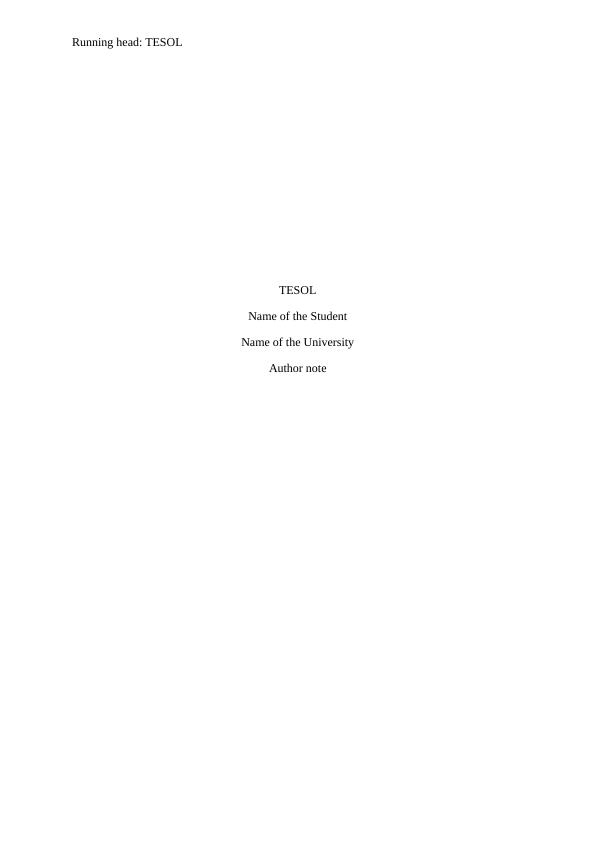
TESOL1
PART A – Critical Evaluation
Introduction
In English as Second Language, English as Foreign Language as well as in English
Language Teaching, the teaching material is one of the most crucial elements that come into
play (Tomlinson, 2012). In that aspect, we need to remember that the design of a teaching
material is not random but rather holds a multitude of theoretical underpinnings that make it
functional (Tomlinson & Masuhara, 2011). When it comes to ESL or EFL materials, the
design is usually based on and targeted towards providing one of the following skill
development trainings – Listening, Speaking, Reading, Writing (Gomathi, 2014), Vocabulary
and Grammar (Baecher, Farnsworth & Ediger, 2014). Furthermore, the purpose of a material
is not to identify and assume the role of a teacher completely but rather to aid the teacher in
the effective delivery of a particular teaching concept (McGreal et al., 2013). In that regard
the material serves the purpose of an aide, or a guide that can help the students even when the
teacher is absent. In the following section, we will be looking at an extract from a material
designed for teaching spoken and vocabulary skills to ESL learners and attempting to break
down and analyse the material from its underlying theoretical perspective.
Discussion
It has been pointed out that the teaching materials that is used in classroom usually
justifies it's presented in the classroom by promoting the linguistic, cultural and general
education aims for the target language programme. It should also facilitate the integration of
the various aspects of language teaching with those of cross curriculum and cross cultural
programmes. It has also been pointed our that in order to be termed a fruitful lesson material,
it should fulfil the primary criteria for the teachers which are
PART A – Critical Evaluation
Introduction
In English as Second Language, English as Foreign Language as well as in English
Language Teaching, the teaching material is one of the most crucial elements that come into
play (Tomlinson, 2012). In that aspect, we need to remember that the design of a teaching
material is not random but rather holds a multitude of theoretical underpinnings that make it
functional (Tomlinson & Masuhara, 2011). When it comes to ESL or EFL materials, the
design is usually based on and targeted towards providing one of the following skill
development trainings – Listening, Speaking, Reading, Writing (Gomathi, 2014), Vocabulary
and Grammar (Baecher, Farnsworth & Ediger, 2014). Furthermore, the purpose of a material
is not to identify and assume the role of a teacher completely but rather to aid the teacher in
the effective delivery of a particular teaching concept (McGreal et al., 2013). In that regard
the material serves the purpose of an aide, or a guide that can help the students even when the
teacher is absent. In the following section, we will be looking at an extract from a material
designed for teaching spoken and vocabulary skills to ESL learners and attempting to break
down and analyse the material from its underlying theoretical perspective.
Discussion
It has been pointed out that the teaching materials that is used in classroom usually
justifies it's presented in the classroom by promoting the linguistic, cultural and general
education aims for the target language programme. It should also facilitate the integration of
the various aspects of language teaching with those of cross curriculum and cross cultural
programmes. It has also been pointed our that in order to be termed a fruitful lesson material,
it should fulfil the primary criteria for the teachers which are
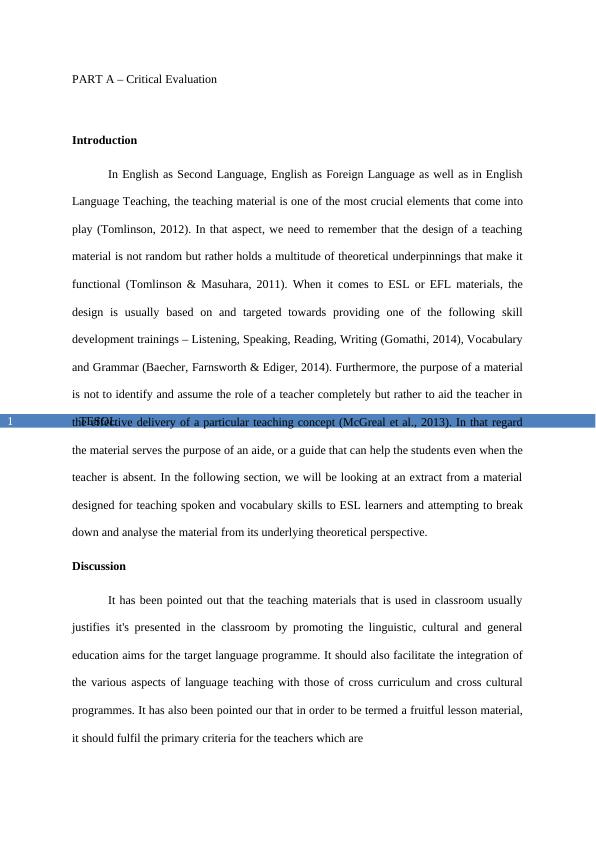
TESOL2
1. They should act as support to the teacher by providing the linguistic input that they
can use.
2. They supply the teacher with a variety of exercises and skill development games that
they can use in the classroom to help the students learn the language.
3. Each material is designed to meet a certain set criteria in terms of syllabus or
curriculum requirement as prescribed for the level.
At the same time, these material must also fulfil some treatments for the students/learner’s as
1. These materials act as concrete tools for the learner's to be able to get exposed to the
target language.
2. They provided enough scaffolding to the learner's to be able to follow a set course for
the study by paid and using the language to learn it well.
The textbook that we are reviewing here is titled “Compelling Conversations”, an
advanced level ESL textbook for development of spoken and vocabulary skills (Roth &
Aberson, 2010, pp. 7-9). We are reviewing the 3rd unit of the book which is dedicated towards
developing home based conversational skills. The unit will be reviewed through the
viewpoint of teacher’s facilitation for teaching, learner's Easter and efficacy of learning and
the cultural significance of the unit. At the same time, three review will also be backed by
theoretical underpinnings that concern the aspect of lesson planning.
The first thing that we need to remember is that the book is designed for advanced
level learners. This automatically entails that the lesson plans would be much more complex
and instead of grammatical requirements, would be much more focussed on discourse
elements.
The first section of the third unit in the book is titled “Sharing Experiences”
(Appendix 1). This section is focussed upon sharing home experiences with a conversation
1. They should act as support to the teacher by providing the linguistic input that they
can use.
2. They supply the teacher with a variety of exercises and skill development games that
they can use in the classroom to help the students learn the language.
3. Each material is designed to meet a certain set criteria in terms of syllabus or
curriculum requirement as prescribed for the level.
At the same time, these material must also fulfil some treatments for the students/learner’s as
1. These materials act as concrete tools for the learner's to be able to get exposed to the
target language.
2. They provided enough scaffolding to the learner's to be able to follow a set course for
the study by paid and using the language to learn it well.
The textbook that we are reviewing here is titled “Compelling Conversations”, an
advanced level ESL textbook for development of spoken and vocabulary skills (Roth &
Aberson, 2010, pp. 7-9). We are reviewing the 3rd unit of the book which is dedicated towards
developing home based conversational skills. The unit will be reviewed through the
viewpoint of teacher’s facilitation for teaching, learner's Easter and efficacy of learning and
the cultural significance of the unit. At the same time, three review will also be backed by
theoretical underpinnings that concern the aspect of lesson planning.
The first thing that we need to remember is that the book is designed for advanced
level learners. This automatically entails that the lesson plans would be much more complex
and instead of grammatical requirements, would be much more focussed on discourse
elements.
The first section of the third unit in the book is titled “Sharing Experiences”
(Appendix 1). This section is focussed upon sharing home experiences with a conversation
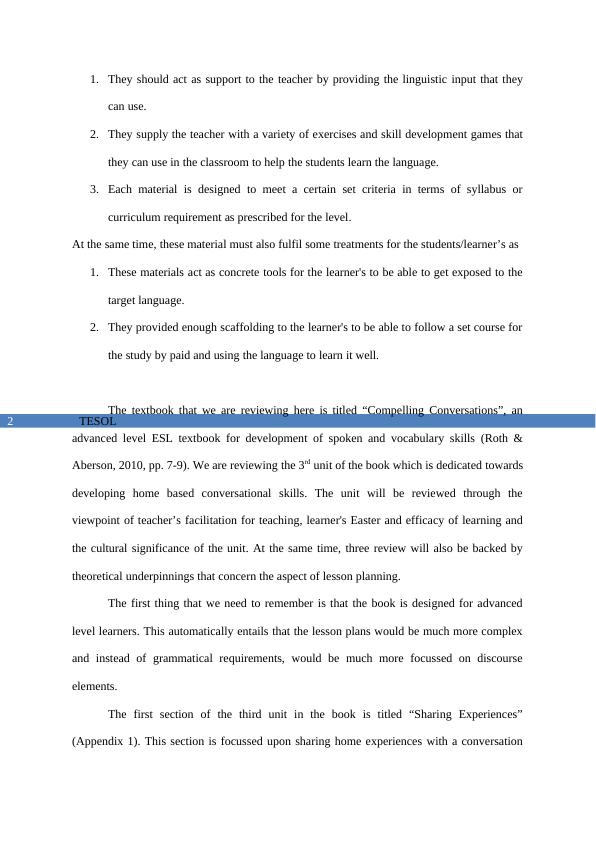
TESOL3
partner. This section has a series of questions that are directed towards understanding and
explaining the personal feelings and connections that one feels with their home. According to
the Common European Framework of Reference (CEFR), the advanced (C1 and C2) levels
are defined as those where the learners are able to (North, 2014):
1. Understand everything that is heard or read with ease.
2. Can express him/herself spontaneously, fluently and precisely without much
searching for expressions.
3. Can use the target language efficiently for social, academic and professional purposes.
Going by those standards, the first activity is a well-structured inclusion as it not only
enables the learner to cognitively engage with the subject but also allows the learner to
actively use learned vocabulary, syntax and discourse markers for engaging in the
conversation (Barraja-Rohan, 2011).
The second section is dedicated towards vocabulary. In this section, the learner is
asked about which of the vocabularies is already known and then in collaboration with a
partner, use each of the vocabulary words to formulate a meaningful sentence. This section is
important as it enables the learner’s critical thinking (Shirkhani and Fahim, 2011),
communicative and collaborative capabilities. Moreover, it also targets a niche category of
words, especially those concerned with household and relative everyday terminology like
mortgage, checklist, neighbourhood, suburb, appliances etc. indicating that the objective here
is to improve the learner’s abilities to target and modify the language for specific context
based purposes. The following section is one on sayings where a few proverbs and sayings
are listed. The learner is asked to identify the meanings of those proverbs, discuss them with
a partner and highlight their favourite. This section therefore targets the ability to understand
metaphorical and symbolic thought processes as well as enables the learner to understand the
target language culture in depth (Kathparia & Carmel, 2011).
partner. This section has a series of questions that are directed towards understanding and
explaining the personal feelings and connections that one feels with their home. According to
the Common European Framework of Reference (CEFR), the advanced (C1 and C2) levels
are defined as those where the learners are able to (North, 2014):
1. Understand everything that is heard or read with ease.
2. Can express him/herself spontaneously, fluently and precisely without much
searching for expressions.
3. Can use the target language efficiently for social, academic and professional purposes.
Going by those standards, the first activity is a well-structured inclusion as it not only
enables the learner to cognitively engage with the subject but also allows the learner to
actively use learned vocabulary, syntax and discourse markers for engaging in the
conversation (Barraja-Rohan, 2011).
The second section is dedicated towards vocabulary. In this section, the learner is
asked about which of the vocabularies is already known and then in collaboration with a
partner, use each of the vocabulary words to formulate a meaningful sentence. This section is
important as it enables the learner’s critical thinking (Shirkhani and Fahim, 2011),
communicative and collaborative capabilities. Moreover, it also targets a niche category of
words, especially those concerned with household and relative everyday terminology like
mortgage, checklist, neighbourhood, suburb, appliances etc. indicating that the objective here
is to improve the learner’s abilities to target and modify the language for specific context
based purposes. The following section is one on sayings where a few proverbs and sayings
are listed. The learner is asked to identify the meanings of those proverbs, discuss them with
a partner and highlight their favourite. This section therefore targets the ability to understand
metaphorical and symbolic thought processes as well as enables the learner to understand the
target language culture in depth (Kathparia & Carmel, 2011).
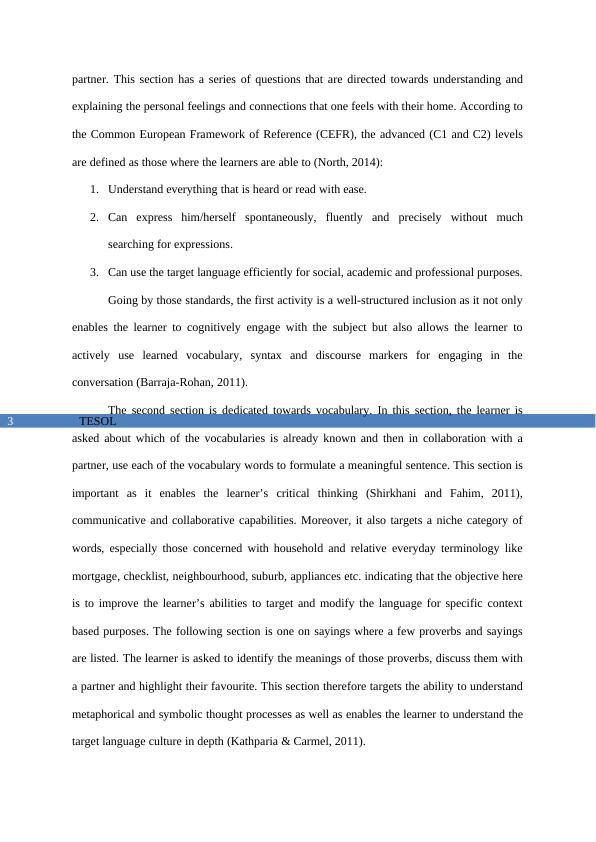
TESOL4
The following section is a continuation of the conversation in the first section. The
rationale for including a continuation section here is to engage the students in relating back to
the beginning of the lesson plan. Furthermore, it also allows for the learner to as well as the
teacher to evaluate specific developments that are noticed in the learner between the first part
of the section and the continuation part, given that there have been sections in between that
have targeted specific developmental areas like vocabulary, communication, critical thinking
and proverbial analysis. Furthermore, an in depth analysis of the questions presented in the
first section and the continuation section gives us a few clarifications regarding the partial
inclusion of the section. Awe can see that in the first part of the section provided at the
beginning, the questions that are asked are more direct and experiential. For instance:
4. Did you have a checklist when looking for a home? What was on it?
5. What legal documents did you have to sign before moving in? Lease? Mortgage? Other?
Did you have to pay any fees?
6. What do you like about it? How long did it take you make a decision?
7. What do you dislike about it? What, if anything, annoys you?
In contrast, the second part of the section targets the more subjective and analytical
part of the learner by asking questions that require an emotionally engaging level of thought
and connection. For instance:
5. Which was your favorite room? Why?
6. Which room was the heart of your childhood home?
7. Have you ever felt homesick? What did you miss the most?
8. What is your favorite childhood memory at home?
From a structural point of view, this inclusion can be justified by explaining that the
continuation section comes after the learner has effectively engaged with proverbs which
entails that the learner has acquired the ability to critically analyse the hidden meanings in a
The following section is a continuation of the conversation in the first section. The
rationale for including a continuation section here is to engage the students in relating back to
the beginning of the lesson plan. Furthermore, it also allows for the learner to as well as the
teacher to evaluate specific developments that are noticed in the learner between the first part
of the section and the continuation part, given that there have been sections in between that
have targeted specific developmental areas like vocabulary, communication, critical thinking
and proverbial analysis. Furthermore, an in depth analysis of the questions presented in the
first section and the continuation section gives us a few clarifications regarding the partial
inclusion of the section. Awe can see that in the first part of the section provided at the
beginning, the questions that are asked are more direct and experiential. For instance:
4. Did you have a checklist when looking for a home? What was on it?
5. What legal documents did you have to sign before moving in? Lease? Mortgage? Other?
Did you have to pay any fees?
6. What do you like about it? How long did it take you make a decision?
7. What do you dislike about it? What, if anything, annoys you?
In contrast, the second part of the section targets the more subjective and analytical
part of the learner by asking questions that require an emotionally engaging level of thought
and connection. For instance:
5. Which was your favorite room? Why?
6. Which room was the heart of your childhood home?
7. Have you ever felt homesick? What did you miss the most?
8. What is your favorite childhood memory at home?
From a structural point of view, this inclusion can be justified by explaining that the
continuation section comes after the learner has effectively engaged with proverbs which
entails that the learner has acquired the ability to critically analyse the hidden meanings in a
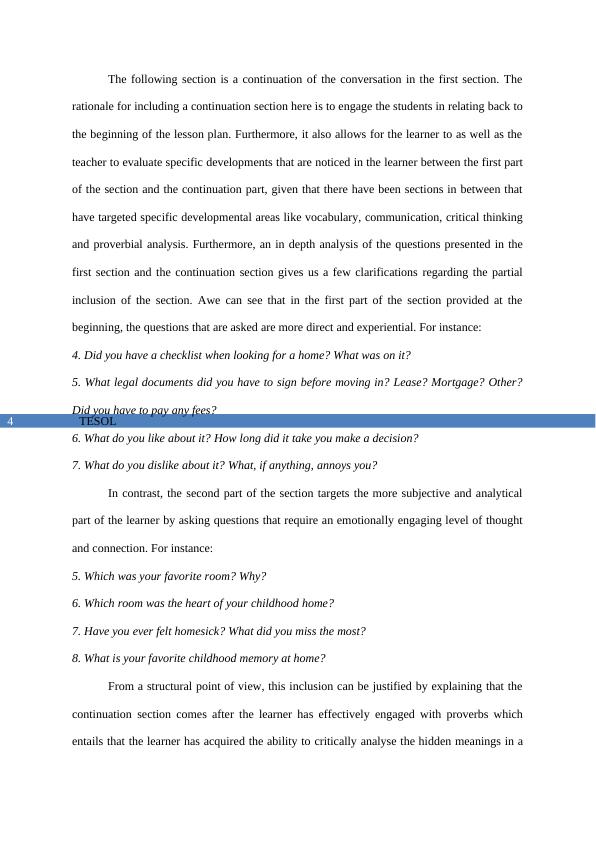
TESOL5
discourse. Therefore asking questions that enable the learner to engage with the emotionally
significant part of his/her life and turn that into a learning material is a fruitful method.
The final section in the unit is based on quotations and engages the learner in a group
based activity where the learner discusses famous quotes, their meanings and significance
and which quote is the learner’s favourite. This section is a more advanced adaptation of the
section involving proverbs. Likewise, it also allows the learner to engage in a group activity
focusing on communication skill development but also rigorously engages the learner’s
critical thinking and reasoning skills where the learner must be able to decode the meanings
of the quotes and elaborate on them.
Theories and approaches
Most of the activities in the unit are group based activities while others are based on
communication through which the learner is able to build upon the skillset that s/he already
possesses. This is indicative of Communicative Language Teaching (CLT) or the
communicative approach (Canale, 2014). It emphasises the aspect of interaction as the means
and objective of language teaching and learning. The theoretical underpinning behind the
approach is the Communicative Competence theory proposed by Dell Hymes (Savignon,
2018). The theory refers to a user’s grammatical knowledge of linguistic elements like
phonology, morphology and syntax and the social knowledge and competence which allows
the individual to use a particular language to his communicative benefit. The unit described
above can be identified to be based upon the CLT approach because primarily, it engages the
learner in a predominantly communicative environment where the aspect of interpersonal
interaction is highlighted as the primary exploratory element.
According to Canale (2014), ESL learners must, in addition to acquiring vocabulary,
phonological and syntactic rules, must also learn the sociolinguistic patterns of the language
they are learning in order to develop full competence. From a methodological viewpoint,
discourse. Therefore asking questions that enable the learner to engage with the emotionally
significant part of his/her life and turn that into a learning material is a fruitful method.
The final section in the unit is based on quotations and engages the learner in a group
based activity where the learner discusses famous quotes, their meanings and significance
and which quote is the learner’s favourite. This section is a more advanced adaptation of the
section involving proverbs. Likewise, it also allows the learner to engage in a group activity
focusing on communication skill development but also rigorously engages the learner’s
critical thinking and reasoning skills where the learner must be able to decode the meanings
of the quotes and elaborate on them.
Theories and approaches
Most of the activities in the unit are group based activities while others are based on
communication through which the learner is able to build upon the skillset that s/he already
possesses. This is indicative of Communicative Language Teaching (CLT) or the
communicative approach (Canale, 2014). It emphasises the aspect of interaction as the means
and objective of language teaching and learning. The theoretical underpinning behind the
approach is the Communicative Competence theory proposed by Dell Hymes (Savignon,
2018). The theory refers to a user’s grammatical knowledge of linguistic elements like
phonology, morphology and syntax and the social knowledge and competence which allows
the individual to use a particular language to his communicative benefit. The unit described
above can be identified to be based upon the CLT approach because primarily, it engages the
learner in a predominantly communicative environment where the aspect of interpersonal
interaction is highlighted as the primary exploratory element.
According to Canale (2014), ESL learners must, in addition to acquiring vocabulary,
phonological and syntactic rules, must also learn the sociolinguistic patterns of the language
they are learning in order to develop full competence. From a methodological viewpoint,

End of preview
Want to access all the pages? Upload your documents or become a member.
Related Documents
Evaluation of English Language Teaching Material (ELT)lg...
|7
|2010
|626
Challenges Faced by English Language Learners and Teachers in ESL Classroomslg...
|14
|3546
|249
Curriculum and Material Designing for Sinhala Medium Government Schoollg...
|18
|5414
|200
Critical English for Academic Purposes in Classroomlg...
|9
|1611
|25
Sample Assignment on Tesol PDFlg...
|10
|2681
|748
Unit Work Outline for TESOLlg...
|7
|1940
|31
